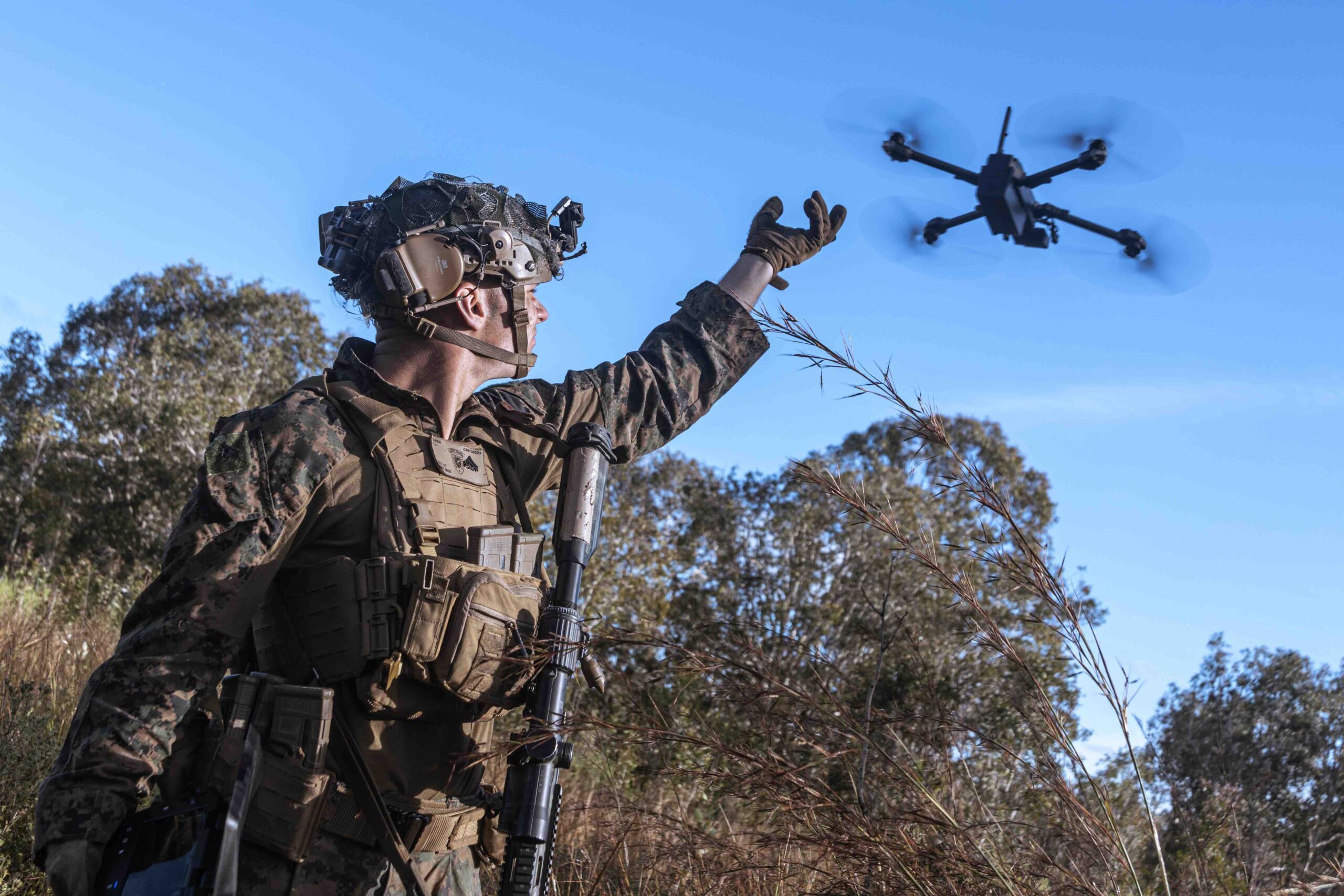On July 10 Defense Secretary Pete Hegseth unveiled a memorandum detailing an initiative seeking to cut the gordian knot slowing down adoption of small aerial drones (SUAS) by the U.S. military.

Besides demanding less restrictive drone operations and procurement standards, the biggest changes involve re-classifying the smallest Group 1 and Group 2 drones as “consumable commodities” that are “cheap, rapidly replaceable”—more like ammunition than “durable” assets.
The memo follow an executive order in June to “Unleashed American Drone Dominance” in June targeting the U.S. drone industry and commercial drones. In typical Trumpian fashion, Hegseth theatrically introduced the memorandum in a video bashing the prior administration’s drone procurement policies, two of which are rescinded by the memo.
The goal, Hegseth said, is to ensure “every squad” is fielding its own expendable SUAS by the end of fiscal year 2026, and to achieve “drone dominance” through a “technological leapfrog.”
Drones as ammunition, not aircraft
The 2020s have seen the Pentagon introduce a succession of programs and policies designed to facilitate the wider-scale integration of SUAS, such as Replicator program—many seeking to reform or bypass cumbersome military procurement systems devised for larger and more expensive manned aircraft.
The problem doesn’t only apply to R&D and procurement. For example, U.S. military units are reportedly reluctant to use and risk damage even low-cost drones in training given how SUAS casualties may be treated similarly to losses of much more valuable assets.
In this ‘consumable’ paradigm, combat units might stockpile, expend and replace drones much as they would mortar shells and anti-tank missiles. Notably, SUAS are extensively used as substitutes/complements for those weapons in the Ukraine-Russia conflict. Furthermore, even non-one-way Group 1 and 2 drones used for ISR, gravity bombing and the like suffered high rates of attrition during frontline use.
The policy also affects who can authorize drone acquisition and upgrades and who can operate them. Specifically, mid-ranking officers down to the O-6 level (colonels, or U.S. Navy captains) are empowered to authorize personnel to operate drones and “procure, test and train with SUAS….from laboratory prototypes to commercial products to molds fabricated by members of the U.S. Armed Forces…”
That’s conditioned on the SUAS complying with the Blue List, “statutory limitations”, and specific component- and cybersecurity standards. The memo says drones developed by service personnel using Blue List components won’t require Blue UAS verification, and that the Blue List itself will be digitized for easy access and to facility continual updates and tester/operational feedback.
Meanwhile, the memo calls for the Army, Navy and Air Force secretaries to “modify or delete all internal policies overregulating procurement, testing, training, and fielding” of SUAS and devise their own “airworthiness and material release” standards. Though worded broadly, the memo specifically says military SUAS need no longer comply with NATO STANAG 4856 standards for interoperable drone control systems. It also seeks to reduce potentially costly requirements for interoperability with legacy control and communication systems.
That change may be welcomed by manufacturers that may view STANAG compliance as excessively expensive relative to the size and complexity of SUAS, though of course it has potential negative impacts on partner interoperability that standard set out to achieve.
Likewise, the memo requests that the Joint Chief of Staff revise the Pentagon’s joint training standard for drone operators (3255.01), last updated in 2011, so that they no longer apply to Group or 1 or 2 drones (“with few exceptions” and “…with minimal additional medical standards applied to small UAS operators.”)
Presumably, the idea is that disseminating SUAS to a much wider array of personnel further down the organizational echelon requires a less stringent standard in operator proficiency. It may also reflect idea that advances in autonomy and control system technology (arguably) reduce the degree of training necessary. The memo also specifies much faster maximum timelines for answering requests for SUAS procurement, allocating frequency, and certifying batteries.
The document also has language encourages other best practices, notably integration of AI, closer fusion of between industry and the military userbase for faster iterative evolution and software-based upgrades, modularity for use of swappable parts, digital twinning for testing, 3D printing of drones by military units, and greater valuation accorded to speed in R&D and procurement pipelines.
Lastly, the memo also called for evaluation of whether to revise Group 3 drone classifications standards, which encompass aircraft weighing between 55 and 1,320 pounds that can fly between 3,500 and 18,000 ft and to speeds of 288 miles per hour. It sounds possible like the lower-end of Group 3 could end up being allocated to Group 2, or that Group 3 may eventually receive similar relaxed regulations to Groups 1 and 2.
Compelling adoption and training of drones
It’s easier to demand “rapid proliferation” of SUAS in the military, it’s another to actually make institutions deviate from their established practices. The memo therefore mandates that the Army, Navy, Marine Corps and Air Force each individually establish active-duty experimental units by September this year dedicated to scaling integration of SUAS. It also requires those services stand up dedicated SUAS program offices, and conduct service-wide reviews over the next 60 days designed to look for capabilities that “would be more cost effective or lethal if replaced by SUAS.”
It also mandates establishment of three “national drone ranges” (at least one with significant water features) in 90 days. These will offer “abundant airspace and allocation” accessible with “low/no inter-service cost transfer” to accelerate testing and training integration.
The memorandum also calls for cooperation with the FAA to “fast-track and expand spectrum approval”, remove “inappropriate…restrictions” near bases, and reduce regulatory constraints to enable more live fire and combined arms training, and swarm testing.
More boosts for U.S. domestic drone industry.
Hegseth said that by 2026 “every squad” (presumably in Army or Marine Corps close combat units) should field a “low cost expendable drone”, with priority accorded to the Indo-Pacific and U.S.-built drones. This requirement may be fulfilled by a relatively new fast-tracked program to develop a cheap kamikaze FPV drone called the Purpose-Built Attritable System (PBAS).
The Indo-Pacific prioritization is not the most natural fit for short-ranged Groupe 1 or 2 SUAS, as in a high-intensity conflict U.S. forces would likely predominantly conduct air and naval warfare over very long distances. However, SUAS might still support marines or special-operation forces in remote islands, littoral naval operations, and ground forces in South Korea.
SUAS have instead most dramatically transformed ground combat operations, particularly in Ukraine where both sides are producing/weaponizing millions of SUAS annually using cheap and numerous civilian-grade parts purchased from China, which occupies a roughly 80% market-share. The extent to which the U.S.’s smaller SUAS industry can provide similar volume and lower prices will be tested, though increased demand from the Pentagon may improve supply and production and generate economies of scale that lower costs.






